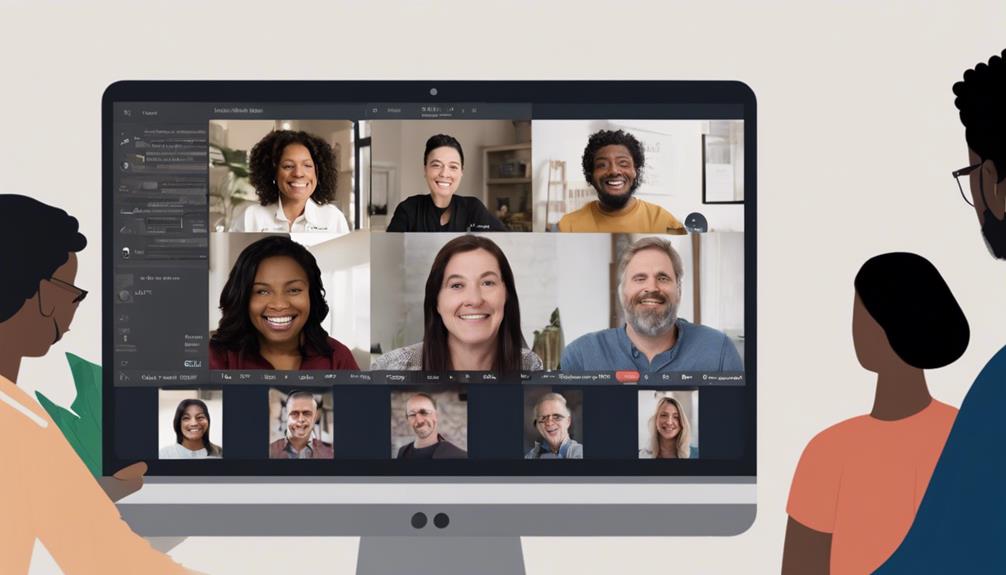Picture yourself driving down a crowded freeway, not realizing that an ambulance is quickly approaching from behind.
Now, picture how an alert system specifically designed for deaf drivers could have signaled the emergency vehicle's presence in time for a safe lane change.
The use of such technology raises critical questions about its effectiveness and practicality in real-life scenarios.
How can these alert systems adapt to various driving conditions and environments, ensuring seamless integration with existing safety measures?
Let's explore the innovative solutions that empower deaf drivers to navigate the roads with confidence and security.
Key Takeaways
- Alert systems provide visual and tactile alerts for deaf drivers, enhancing their safety on the road.
- Visual cues and vibrating alerts compensate for auditory limitations, improving situational awareness.
- Specialized technology like the SirenSensorTM autoMOBILETM system revolutionizes safety measures for deaf drivers.
- Smartphone connectivity solutions and alarm devices boost confidence and awareness while driving.
Challenges Faced by Deaf Drivers
Deaf drivers encounter significant challenges due to their inability to hear emergency sirens, impacting their prompt response on the road. The lack of auditory cues can result in hazardous situations as detecting approaching emergency vehicles becomes difficult.
To compensate, deaf drivers heavily rely on visual cues such as flashing lights and vibrations to stay vigilant while driving. However, these cues may not always be sufficient, especially in noisy environments or when they aren't in direct line of sight.
This is where specialized alert systems play a crucial role in enhancing road safety for deaf drivers. These systems are designed to provide visual and tactile alerts that effectively communicate potential dangers on the road.
Importance of Alert Systems

Alert systems play a vital role in ensuring the safety of deaf drivers on the road.
These systems provide essential visual or vibrational alerts for sounds that deaf drivers may not hear, such as emergency vehicles or car horns.
Alert System Benefits
Understanding the importance of alert systems for drivers facing hearing challenges is crucial for enhancing road safety and ensuring timely notification of critical information. Alert systems provide deaf drivers with real-time safety notifications, utilizing visual, vibrotactile, and smartphone alerts. By detecting emergency sounds and other important alerts, these systems significantly enhance road safety. They assist deaf drivers in navigating traffic, responding to alarms, and staying informed while on the road. Implementing alert systems not only improves communication but also boosts situational awareness for deaf drivers, ultimately contributing to their safety on the road.
| Alert System Benefits |
|---|
| Real-time safety notifications |
| Enhanced road safety |
| Improved communication and situational awareness |
Safety Measures for Deaf Drivers
Recognizing the challenges faced by drivers with hearing impairments underscores the significance of incorporating safety measures tailored to their needs.
For deaf drivers, alert systems play a vital role in enhancing road safety by providing visual cues and vibrating alerts for hazard detection.
These specialized systems offer emergency alerts through flashing lights and tactile feedback, compensating for auditory limitations.
By utilizing these innovative technologies, deaf drivers can improve their situational awareness and communication on the road, ultimately contributing to safer driving experiences.
The alert system not only assists in detecting important auditory signals such as sirens and horns but also empowers deaf individuals to navigate traffic confidently.
Prioritizing these safety measures is essential for ensuring the well-being of all drivers.
Technology for Deaf Drivers
Have you ever considered how technology is revolutionizing the safety measures available to deaf drivers on the road? With specialized technology and advanced safety devices, deaf drivers now have access to a range of innovative solutions to enhance their driving experience. Here are some key technologies that are making a difference:
- Assistive listening devices
- Vibrating alerts
- Visual cues
- Emergency vehicle detection
- Phone connectivity solutions
These tools provide crucial notifications for sounds like ringing phones, doorbells, and emergency sirens, ensuring that deaf drivers stay informed and safe while on the road. Additionally, with features like advanced alarm clocks and specialized technology such as the SirenSensorTM autoMOBILETM system, deaf drivers can navigate the roads with confidence.
Types of Alerting Devices

When exploring the world of alerting devices for deaf drivers, it becomes evident that visual, vibrotactile, and auditory signals play crucial roles in enhancing safety and connectivity. Visual signals, such as flashing lights or strobes, grab immediate attention during emergencies. Vibrotactile signals, like vibrating alerts, provide discreet notifications without the need for sound.
Auditory signals, including alarms with adjustable tones and volumes, offer flexibility for different preferences. Smartphone technology further enhances connectivity by enabling vibrating notifications for doorbell cameras and other smart home devices. These alerting devices are specifically designed to operate independently of hearing aids, ensuring deaf drivers remain informed, especially during sleep when traditional auditory cues may not be effective.
Systems like the Sonic Alert HomeAware II go beyond basic alerts, offering comprehensive safety and connectivity features tailored to the unique needs of deaf drivers. By incorporating a mix of visual, vibrotactile, and auditory signals, these devices create a robust alerting system that keeps deaf drivers safe and connected on the road.
Advantages of Alert Systems

Exploring the realm of alert systems for deaf drivers uncovers a multitude of benefits that significantly enhance safety and communication on the road. Alert systems offer advantages that cater to the specific needs of deaf drivers, empowering them to navigate the road environment with confidence and security. Here are some key advantages of utilizing alert systems:
- Increased Situational Awareness: Alert systems provide visual, vibrational, and text-based alerts, enhancing the driver's awareness of their surroundings.
- Improved Communication: These systems enable deaf drivers to stay informed about important auditory cues such as emergency vehicles, doorbells, and phone calls.
- Enhanced Response: By customizing alert systems to individual preferences, drivers can respond more effectively to potential dangers on the road.
- Personalized for Individual Needs: Alert systems can be tailored to suit the unique preferences and requirements of each driver, ensuring optimal communication and safety.
- Boosting Confidence and Security: Overcoming auditory limitations, alert systems instill a sense of confidence in deaf drivers, allowing them to drive securely and with peace of mind.
Integration With Driving Technology

Integrating alert systems with driving technology enhances safety and communication for deaf drivers on the road. By seamlessly incorporating advanced alert systems into vehicles, deaf drivers can receive real-time notifications about potential hazards. These systems utilize visual cues, vibrations, and other sensory inputs to ensure that deaf drivers stay informed and aware while driving. The integration with driving technology not only improves safety but also increases the overall driving experience for deaf individuals.
Smart sensors and AI technology play a crucial role in revolutionizing how alert systems are integrated into vehicles for deaf drivers. These technologies enable the creation of more sophisticated alert systems that can adapt to different driving situations and provide personalized assistance. By leveraging the capabilities of driving technology, deaf drivers can navigate roads more confidently and efficiently, knowing that they've reliable support in place to alert them to any dangers or obstacles they may encounter.
Enhancing Safety on the Road

To enhance safety on the road for deaf drivers, incorporating advanced alert systems that provide visual, vibrational, and smartphone notifications is crucial. Specialized devices like alarm clocks, smoke alarms, and doorbell signalers help deaf drivers stay aware of their surroundings.
Alerting devices use a combination of strobing lights, vibrations, and loud audio signals to ensure safety on the road. Smartphone technology enables deaf drivers to receive notifications from doorbell cameras and stay connected while driving.
Safety measures like the PionEar smart sensor aid in detecting emergency vehicle sounds, providing visual alerts to deaf drivers for increased safety.
- Specialized devices such as alarm clocks and doorbell signalers enhance awareness.
- Alerting devices utilize strobing lights, vibrations, and loud audio signals for safety.
- Smartphone technology allows for notifications and connectivity while driving.
- Safety measures like the PionEar smart sensor detect emergency vehicle sounds.
- Visual alerts play a crucial role in enhancing safety for deaf drivers.
Frequently Asked Questions
How Can Deaf People Drive Safely?
We rely on visual cues and specialized alert devices to drive safely. Our brain scans reveal the use of auditory centers for sensing vibrations while driving.
Our superior peripheral vision enhances our road awareness. Devices in our cars help us detect sirens and crucial sounds for safe driving.
The National Relay Service is vital in reaching emergency services. Together, we navigate the roads with confidence and adaptability.
What Is the Alert System for Deaf People?
We've got the scoop on the alert system for deaf folks! It's a game-changer, using visual, vibrotactile, and smartphone alerts for safety at home. No need for hearing aids; this tech is top-notch.
Devices like the Sonic Alert HomeAware II do it all – alarm clock, caller ID, and security monitor.
Stay tuned for more ways this system is revolutionizing connectivity and safety for the deaf community.
What Are Some Safety Measures for Deaf?
When it comes to safety measures for the deaf, it's crucial to have visual and vibrational alerts in place. Devices that can detect emergency sounds and provide visual cues are essential. Specialized alarm clocks and doorbell signalers play a vital role in alerting deaf individuals to important sounds.
Additionally, cell phones with caption apps and connectivity solutions discreetly notify us of alerts. These measures are essential for our safety on the road.
What Do Deaf People Use for Alarms?
We rely on specialized alarm clocks with strobe lights and bed-shakers for waking up. These alarms are designed to cater to the needs of the hard of hearing community, featuring loud alerts, flashing lights, and vibrating elements.
Smartphone technology also plays a crucial role by providing vibrating notifications for various alerts.
Safety devices such as enhanced smoke alarms and doorbell signalers are essential for our security and awareness in different situations.
How Can Alert Systems and Smart Glasses Help Deaf Drivers Stay Safe on the Road?
Alert systems and smart glasses for communication can greatly assist deaf drivers in staying safe on the road. These technologies can alert them to emergency vehicles, honking horns, or nearby sirens. Additionally, smart glasses for communication can provide visual cues and notifications, enhancing their awareness and ensuring a safer driving experience.
How Can Deaf Drivers Use Alert Systems to Stay Safe?
Deaf drivers can use the deaf alert bracelet safety to stay safe on the road. These alert systems can include visual alerts for emergency vehicles, doorbells, and alarms, ensuring that deaf drivers can remain aware of their surroundings while driving. This technology helps prevent accidents and improves overall road safety for deaf drivers.
Conclusion
In conclusion, deaf drivers face unique challenges on the road that can be mitigated with the help of alert systems. By incorporating visual, vibrotactile, and auditory signals into their driving routine, they can stay informed and respond effectively to potential hazards. These technologies not only enhance safety but also provide peace of mind for both the driver and others on the road.
Stay safe, stay alert, and drive with confidence knowing you have the tools to navigate the road with ease.











